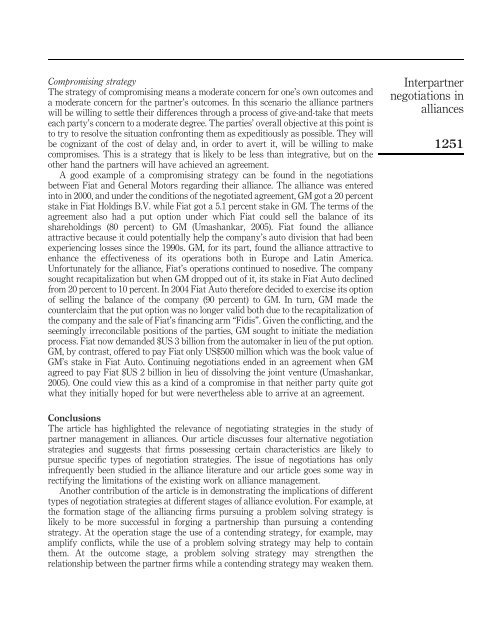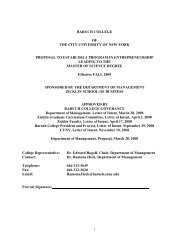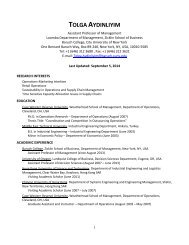alliances a strategic framework
Download - zicklin : school of business - CUNY
Download - zicklin : school of business - CUNY
- No tags were found...
You also want an ePaper? Increase the reach of your titles
YUMPU automatically turns print PDFs into web optimized ePapers that Google loves.
Compromising strategy<br />
The strategy of compromising means a moderate concern for one’s own outcomes and<br />
a moderate concern for the partner’s outcomes. In this scenario the alliance partners<br />
will be willing to settle their differences through a process of give-and-take that meets<br />
each party’s concern to a moderate degree. The parties’ overall objective at this point is<br />
to try to resolve the situation confronting them as expeditiously as possible. They will<br />
be cognizant of the cost of delay and, in order to avert it, will be willing to make<br />
compromises. This is a strategy that is likely to be less than integrative, but on the<br />
other hand the partners will have achieved an agreement.<br />
A good example of a compromising strategy can be found in the negotiations<br />
between Fiat and General Motors regarding their alliance. The alliance was entered<br />
into in 2000, and under the conditions of the negotiated agreement, GM got a 20 percent<br />
stake in Fiat Holdings B.V. while Fiat got a 5.1 percent stake in GM. The terms of the<br />
agreement also had a put option under which Fiat could sell the balance of its<br />
shareholdings (80 percent) to GM (Umashankar, 2005). Fiat found the alliance<br />
attractive because it could potentially help the company’s auto division that had been<br />
experiencing losses since the 1990s. GM, for its part, found the alliance attractive to<br />
enhance the effectiveness of its operations both in Europe and Latin America.<br />
Unfortunately for the alliance, Fiat’s operations continued to nosedive. The company<br />
sought recapitalization but when GM dropped out of it, its stake in Fiat Auto declined<br />
from 20 percent to 10 percent. In 2004 Fiat Auto therefore decided to exercise its option<br />
of selling the balance of the company (90 percent) to GM. In turn, GM made the<br />
counterclaim that the put option was no longer valid both due to the recapitalization of<br />
the company and the sale of Fiat’s financing arm “Fidis”. Given the conflicting, and the<br />
seemingly irreconcilable positions of the parties, GM sought to initiate the mediation<br />
process. Fiat now demanded $US 3 billion from the automaker in lieu of the put option.<br />
GM, by contrast, offered to pay Fiat only US$500 million which was the book value of<br />
GM’s stake in Fiat Auto. Continuing negotiations ended in an agreement when GM<br />
agreed to pay Fiat $US 2 billion in lieu of dissolving the joint venture (Umashankar,<br />
2005). One could view this as a kind of a compromise in that neither party quite got<br />
what they initially hoped for but were nevertheless able to arrive at an agreement.<br />
Interpartner<br />
negotiations in<br />
<strong>alliances</strong><br />
1251<br />
Conclusions<br />
The article has highlighted the relevance of negotiating strategies in the study of<br />
partner management in <strong>alliances</strong>. Our article discusses four alternative negotiation<br />
strategies and suggests that firms possessing certain characteristics are likely to<br />
pursue specific types of negotiation strategies. The issue of negotiations has only<br />
infrequently been studied in the alliance literature and our article goes some way in<br />
rectifying the limitations of the existing work on alliance management.<br />
Another contribution of the article is in demonstrating the implications of different<br />
types of negotiation strategies at different stages of alliance evolution. For example, at<br />
the formation stage of the alliancing firms pursuing a problem solving strategy is<br />
likely to be more successful in forging a partnership than pursuing a contending<br />
strategy. At the operation stage the use of a contending strategy, for example, may<br />
amplify conflicts, while the use of a problem solving strategy may help to contain<br />
them. At the outcome stage, a problem solving strategy may strengthen the<br />
relationship between the partner firms while a contending strategy may weaken them.
















